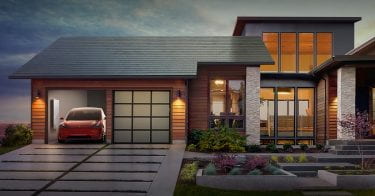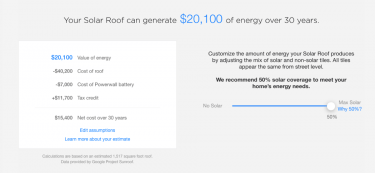May 25, 2017
Will Tesla’s Solar Roof provide cost-effective electric vehicle charging in Seattle?

Eric Barber
Last Fall Tesla unveiled one of its newest products, the solar roof. What separates this solar panel from other solar panels is its aesthetics. As opposed to your traditional solar panels, these panels offer a more incognito design, which is meant to mimic different types of traditional roofing styles. The styles include Tuscan shingle and also a slate shingle, as well as a couple others. Visually, I was blown away by the product upon watching Elon Musk unveil the new product in this video. However, I was skeptical that the price would be anywhere near something I would be able to afford, that is until he said that the pricing was less than the cost of a roof. Exact prices were not released at the same time as the product, however, recently they have released the pricing of the products, which varies based off the number of solar tiles you plan to buy. The number of panels, of course is based off the amount of energy the occupants typically use. However, when looking at these numbers I began to wonder how much it would cost to buy enough tiles to charge a Tesla, and what additional demand for energy this would put onto the solar roof. For the purpose of this question I will focus it to the Seattle area where I live, and the cost of the tiles needed for generating enough energy for the car in this particular area.

In doing this analysis I would need to have the cost of tiles as well as the amount of energy generated by the tiles, however, I am not able to find the amount of energy that each of the tiles can produce in optimal conditions. The only thing that I am able to find is the cost calculators on this page. Using the outcome for my house I should be able to assess how much Tesla expects each square foot of solar will generate in my area, and then use this to assess the cost of installing enough tiles to charge a Tesla. Here are my results for the solar calculator:

In this scenario Tesla suggests that I use 50% solar which would equate to 758.5 sq ft of solar. This would generate a total energy value of $20,100 over 30 years. This number is calculated using an average electricity cost from my area of 9.27 cents per kWh, and it also takes into account a 2% yearly increase in cost due to inflation. Assuming Tesla is using a consistent yearly energy demand, this means they think that the panels on my roof would generate 5345 kWh of energy per year. This is less than half of the 10,812 kWh demanded by the average house, according to the EPA. If I owned a Tesla Model S P100D, then I would get a range of 315 miles on a 100 kWh battery. Assuming I would drive at the US average of 13,476 miles then I would need to recharge my car approximately 43 times to get 4300 kWh of energy. This would be about 80% of the total energy my solar roof could produce in a year. At a price tag of $40,200 (not including the Powerwall, which you also need), this means that the cost of the roof is $ 1,340 per year for 30 years. Eighty percent of this yearly cost would be $1,072, which would represent the yearly cost for me to use the Tesla Solar Roof to charge my beloved Tesla Model S P100D. To put this in perspective, at a combined 31 mpg, a Lexus GS Hybrid would need an equivalence of 430 gallons of gas a year to drive the same distance. At an average price of $2.90/gallon, this would cost $1,260 a year to drive using gas. At these values, the solar roof in Seattle would keep the cost of fuel cheaper for a Tesla, then what you would expect to pay with a gas car in a year. Moreover, in a more solar friendly area, unlike Seattle this year, the solar roof would be an even more cost effective way to generate energy.
To close, one thing to note is that the biggest benefit of the solar roof is that the energy that you will be consuming will be coming from clean sources, and the true cost of the energy will be the cost borne by the owner. Moreover, the true cost of gasoline is not actually what people are paying. Because of this, I think that when looking at the true cost, solar roofs would certainly be favored over gasoline, and will more often than not be favored over grid electricity that often comes from unsustainable sources.
Recent Comments